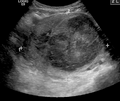Interventional Radiology facts for kids
Interventional radiology is a special part of medicine. Doctors in this field use tiny tools and imaging (like x-rays or ultrasound) to diagnose and treat illnesses inside your body. They do this without needing big surgeries.
Sometimes, they use these methods to find out what's wrong (diagnose). Other times, they use them to fix the problem (treat). Imagine doctors having a 'GPS' for your body! They use pictures from X-rays or ultrasound to see inside. This helps them guide small tools, like thin needles or tiny tubes called catheters, right to where the problem is. It's like a super precise way to help you get better.
Contents
What is Interventional Radiology?
Interventional radiology, often called IR, is a modern way to treat many health problems. It's different from traditional surgery because doctors don't make large cuts. Instead, they use very small openings in the skin. This means less pain and a faster recovery for patients.
Doctors who specialize in IR are called interventional radiologists. They are experts at reading medical images. They use these images to guide their tools safely inside the body.
How Does Interventional Radiology Work?
The main idea behind IR is to use images as a guide. Think of it like using a map to find your way. Doctors use real-time images from machines like X-ray, ultrasound, CT scans, or MRI. These images show them exactly where to go inside your body.
They make a tiny cut, often just a pinprick. Then, they insert thin tools like needles or catheters. A catheter is a very thin, flexible tube. They guide these tools through blood vessels or other pathways. This leads them directly to the area that needs treatment.
Tools and Technology
Interventional radiologists use several cool technologies:
- X-rays: These help doctors see bones and some organs. They can track tools moving inside the body.
- Ultrasound: This uses sound waves to create live pictures of organs and blood flow. It's great for guiding needles.
- CT scans: These make detailed 3D images of the body. They help plan complex procedures.
- Catheters: These tiny tubes can deliver medicine or tiny devices. They can also take samples.
- Needles: Very thin needles are used to take biopsies (small tissue samples) or drain fluids.
Why Do Doctors Use Interventional Radiology?
Doctors choose IR for many reasons. It's often safer than open surgery. It also helps patients get back to their normal lives much quicker.
Benefits of IR
- Less invasive: It means fewer cuts and smaller scars.
- Less pain: Patients usually feel less pain after the procedure.
- Faster recovery: You can often go home the same day or very soon after.
- Lower risk: There's often less chance of infection or other problems.
- Precise targeting: Doctors can reach exact spots inside the body.
Common Procedures
Interventional radiology can treat many different conditions. Here are a few examples:
- Treating blockages: Doctors can open blocked blood vessels. This helps blood flow better.
- Stopping bleeding: They can find and stop bleeding inside the body.
- Draining fluid: Sometimes, too much fluid builds up. IR can help drain it safely.
- Taking biopsies: They can take tiny tissue samples to check for diseases like cancer.
- Treating tumors: They can deliver medicine directly to tumors or destroy them with heat or cold.
Interventional radiology is a growing field. It offers amazing ways to help people get better without major surgery.
Images for kids
See also
 In Spanish: Radiología intervencionista para niños
In Spanish: Radiología intervencionista para niños



